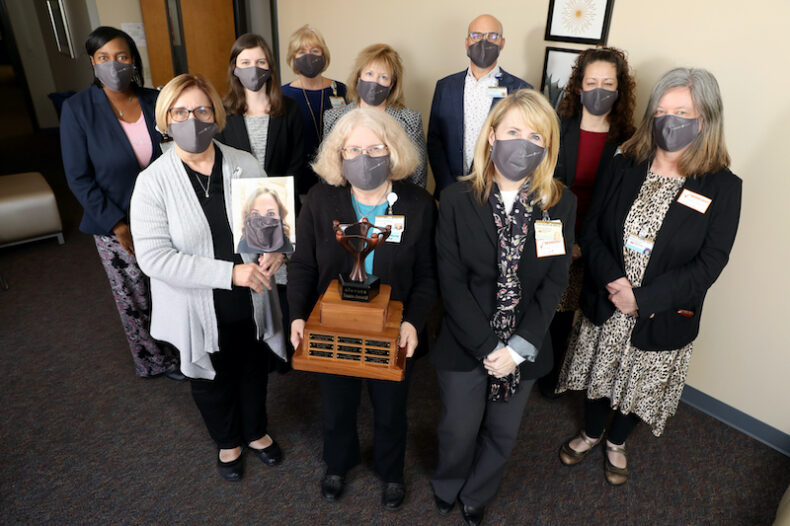Vanderbilt University Medical Center (VUMC) is the first hospital system in the nation to receive the Association for Professionals in Infection Control and Epidemiology (APIC) Program of Distinction designation, an acknowledgement of excellence for infection prevention and control programs that meet stringent standards established by the association.
The designation is the culmination of an intensive review process that began last summer when an APIC survey team visited VUMC to evaluate infection prevention practices at Vanderbilt University Adult Hospital and Monroe Carell Jr. Children’s Hospital at Vanderbilt as well as numerous off-site locations.
APIC is the leading professional association for infection preventionists (IPs) in the United States, with more than 15,000 members. APIC’s Program of Distinction designation measures excellence in infection prevention policies and procedures and ongoing quality improvement efforts, as well as compliance with federal regulations.
“We are happy to award the first APIC Program of Distinction designation to Vanderbilt University Medical Center,” said APIC CEO Katrina Crist, MBA, CAE. “Their program embodies the standards of excellence that we envisioned when we created this program. We congratulate them on their superior efforts to protect patients and prevent infection.”

“We’re honored to be the first institution in the country to receive this designation,” said Thomas Talbot, MD, MPH, professor of Medicine and Chief Hospital Epidemiologist at VUMC. “One of the big things the surveyors cited was that it is not just the Infection Prevention team that contributed to the effectiveness of our infection prevention programs.
“They saw that the commitment to infection prevention permeates the institution, throughout all levels, from leadership to the front line. This achievement validates our institution-wide dedication to patient safety, our collaboration and teamwork and every individual’s effort in implementing and consistently following best practices to prevent the spread of healthcare-associated infections.”
“This award represents many years of focused effort in infection prevention, and it is a distinction of our great VUMC team,” said Gerald Hickson, MD, Senior Vice President for Quality, Safety and Risk Prevention. “To achieve this level of recognition, our programs were examined closely by national leaders in infection control. We were found to have exemplary programs, beginning with every team member’s commitment to washing their hands.”
During the review process, the Infection Prevention team provided data on VUMC’s healthcare-associated infection (HAI) rates, and across the board the numbers were positive, Talbot said. For example, from 2009 to 2017 (estimated with six months of data in 2017), central line associated blood stream infections (CLABSI) in the intensive care units (ICU) were reduced by 79 percent, and non-ICU CLABSIs were reduced by 71 percent. From 2010 until 2017, there was an estimated 61 percent increase in the healthcare worker influenza vaccination rate. From 2009 until 2017, there was an estimated 81 percent increase in hand-hygiene compliance.
“The entire VUMC organization demonstrated commitment to actively integrating infection prevention into routine patient care practices,” said Terrie Lee, RN, MS, MPH, strategy and clinical lead for the APIC Program of Distinction. “We noted that Infection Prevention and Quality have been working collaboratively to address issues in a highly successful manner. There were also obvious forward-thinking, ‘Wow’ moments identified when we reviewed their methods of instrument reprocessing (high-level disinfection and sterilization), as well as the surveillance and data management system, antibiotic stewardship program, and their unit for care of patients with highly infectious diseases.”

APIC surveyors visited VUMC in 2016 to observe specific infection control and epidemiology initiatives. They focused on many areas, including disinfection/sterilization, emergency preparedness, occupational health and antibiotic stewardship. The APIC team observed and spoke with front line clinicians, as well as Infection Prevention team members and visited clinical, procedural and support services areas, said Director of Infection Prevention Vicki Brinsko, MSN, RN.
“This review process has been important, not only for our team to confirm that they’re doing really great work, but also within the institution, to reaffirm strong, collaborative relationships with other teams like environmental services, facilities management, and environmental health and safety,” said Brinsko. “We work closely together every day, and this is an outside agency coming in, looking at how we do things and saying, ‘Thumbs up.’”
In 2014, the Centers for Disease Control and Prevention (CDC) released results from its Healthcare-associated Infection (HAI) Prevalence Survey. On any given day, one in 25 hospital patients has at least one HAI. In 2011, there were an estimated 722,000 HAIs in U.S acute care hospitals each year, and about 75,000 hospital patients with HAIs died during their hospitalizations.
The APIC Program of Distinction designation has been awarded to VUMC for a three-year period. At the end of that time, the Medical Center can repeat the review process.
At VUMC, the Department of Infection Prevention includes six epidemiologists, eight infection preventionists, and a data analytics team. The VUMC Infection Prevention Regulatory Subcommittee and the Infection Prevention Executive Committee, which include representatives from throughout the Medical Center, meet bimonthly to evaluate policies, review current infection prevention programs and HAI-prevention performance, and discuss current infection prevention concerns.















